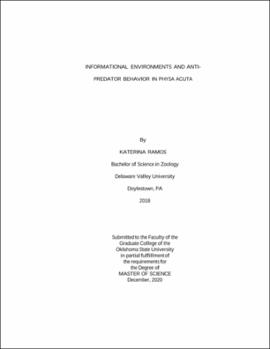| dc.contributor.advisor | Luttbeg, Barney | |
| dc.contributor.author | Ramos, Katerina | |
| dc.date.accessioned | 2023-08-16T18:18:55Z | |
| dc.date.available | 2023-08-16T18:18:55Z | |
| dc.date.issued | 2020-12 | |
| dc.identifier.uri | https://hdl.handle.net/11244/338861 | |
| dc.description.abstract | Informational environments can alter how well predators and prey can find and avoid each other, and change how much certainty individuals experience. The impacts this has on ecological dynamics needs more investigation. Luttbeg and Trussell (2013) developed a mathematical model to describe predator-prey interactions when informational environments are unreliable. Their model predicted that an individual from an unreliable environment will not rely on alarm cues as much as individuals from reliable environments. Based on this model, I hypothesized that how individuals respond to the absence and presence of predator cues will be affected by the reliability of information in their ancestral environment. Within aquatic systems, cue disruption can be due to flow regime and flow magnitude. The rate and direction of water flow can disrupt the chemical cues prey use to detect predators. Using the freshwater snail, Physa acuta, and its crayfish predator, Orconectes simulans, I tested how responses of individuals to the absence and present of predator cues depended on whether their parents came from flowing or not flowing environments. Each individual was tested in a no flow environment with control (water) cue and a predator (crayfish odor) cue, they were then tested in a flow environment with only control cue. I found the type of environment that individuals came from did not affect their responses, but there were differences in correlated with the shape of individuals and the average shape of individuals from the collection location. This showed that ancestral environment plays a role in the offspring’s ability to adapt to diverse informational environments. When I observed behavior without morphological shape, I found that the behavior of individuals differed among collection locations, no matter the type of informational environment they were from. The lack of behavioral differences could be explained by the differences of shell shape between reliable and unreliable environments. My findings do not completely validate the mathematical model predictions, but do confirm an interaction between informational reliability and individual ancestral environment. | |
| dc.format | application/pdf | |
| dc.language | en_US | |
| dc.rights | Copyright is held by the author who has granted the Oklahoma State University Library the non-exclusive right to share this material in its institutional repository. Contact Digital Library Services at lib-dls@okstate.edu or 405-744-9161 for the permission policy on the use, reproduction or distribution of this material. | |
| dc.title | Informational environments and anti-predator behavior in Physa acuta | |
| dc.contributor.committeeMember | Wilder, Shawn | |
| dc.contributor.committeeMember | Dzialowski, Andy | |
| osu.filename | Ramos_okstate_0664M_16912.pdf | |
| osu.accesstype | Open Access | |
| dc.type.genre | Thesis | |
| dc.type.material | Text | |
| thesis.degree.discipline | Integrative biology | |
| thesis.degree.grantor | Oklahoma State University | |
